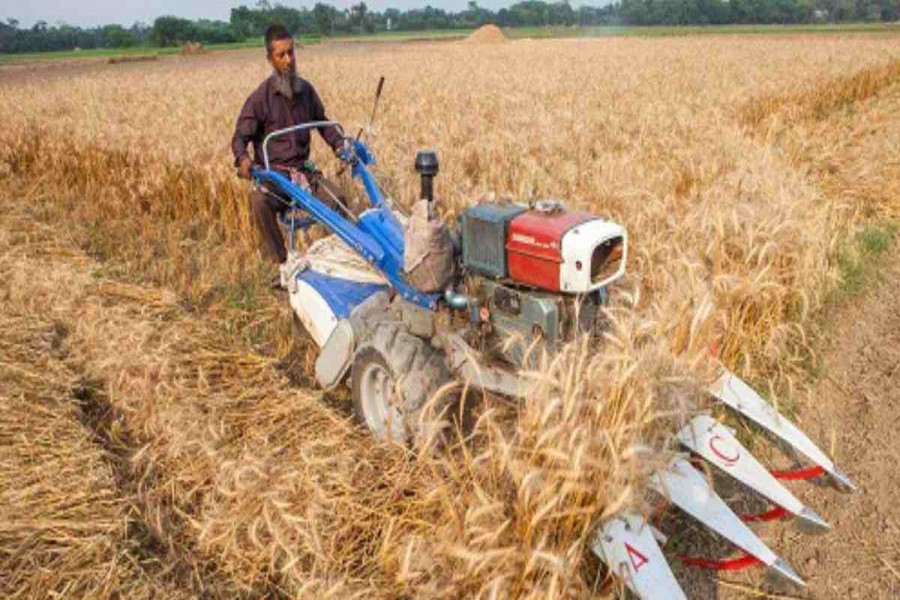Reducing production cost in agriculture and increasing the yield are sometimes seen as separate ventures, which experts disagree holding the view that mechanisation can help achieve both. The government's agri-mechanisation project, though belated, is believed to cause a dynamic improvement in the overall makeup of the agriculture sector.
The country's agriculture sector is a lot different from what it was a decade ago. While a good deal of activities earlier done manually has been replaced by mechanised methods, farm literacy has also seen considerable improvement thanks to the good job of the extension workers. However, the situation still demands massive improvement to properly utilise mechanisation.
A recent study on the agricultural sector shows that although mechanisation has made quick strides there, it is mostly confined to the use of power tillers, tractors and power pumps. There are other important areas in cultivation where more and more mechanisation can be fruitfully introduced. But as the study shows, major barriers to using mechanised cultivation in the country include dearth of skilled and semi-skilled workers to operate modern tools, complexity in maintaining and repairing those and power shortage.
Looking at these barriers in isolation may be misleading. These have resulted mostly from flawed planning, according to experts, leading to improper distribution of mechanised agricultural tools, unaffordable prices, incomplete or inadequate information about the advantages of using the tools, inadequate training facilities for farmers and so on. The study identified the level of adoption of agricultural mechanisation in different divisions of Bangladesh, farmers' use of modern tools, their willingness to adopt modern tools, their satisfaction level regarding availability of labour, skills of modern tool users, and perception about future demand and shortage in using agricultural machinery.
Experts believe that to meet the increased demand of growing population, it is imperative to give serious attention to agricultural mechanisation that can help the country address the rising demand, decreasing cultivable land and shortage of agricultural labour during seeding and harvesting seasons. They strongly believe that expanding the sphere of mechanisation will result in raising efficiency and economising the cost of cultivation, besides substantially reducing post-harvest losses due to wastage. It is commonly believed that due to manual handling, 10 to 15 per cent of the crop, especially paddy, gets lost at harvesting and post-harvesting stages.
Machines and equipment such as seeder, transplanter and power thresher are sure to bring a lot of change in terms of increased productivity and cropping intensity at lower costs than now. In fact, mechanisation could be the only way out to add value to cultivation, especially paddy cultivation. In the Asian region, countries that have reaped the most from mechanised cultivation are China and Thailand. For Bangladesh, this is a transition phase. To encourage farmers to embrace mechanisation, schemes must be in place to provide affordable ways for procuring necessary tools and implements. Forming cooperative societies comprising small farmers could expand the facility to a hugely larger number of farmers. Non-governmental organisations (NGOs) can also have a meaningful role to play in this regard.
It is commonly alleged that because of the high cost of cultivation, it is at times not possible for farmers to even recover the money invested in cultivation, let alone make profit. This has led rural population, even in areas where agriculture is the only means of livelihood, to opt for non-farm jobs or urban migration. In this context, it may be worthwhile to mention that non-farm jobs that are attracting a section of the farm population are otherwise largely reliant on farm-based activities. So, the only way to make rural livelihood better and self-sustaining is to put sufficient thrust on both farm and non-farm activities. And, non-farm activities can grow only when agriculture gets the required boost. It is also important to note that despite the shift from farm to non-farm jobs, 87 per cent of rural households still rely on farm income that besides major crop cultivation, includes horticulture, fisheries, poultry etc.
While boosting non-agricultural activities is important for rural livelihood, required impetus to agriculture is crucial that can come through mechanisation. High-value agriculture is the need of the hour. It is here that mechanisation and crop diversity can play the pivotal role.
To achieve this, a well-planned strategy has to be in place. The agri-mechanisation project of the government referred to above may well be an important step towards such a strategy. The Executive Committee of the National Economic Council (ECNEC) last week approved Tk 30.20 billion for agricultural mechanisation. The agricultural extension department will implement the project by December 2025. The main activities of the project include procurement and distribution of 51,300 machines (combined harvester, rice transplanter, power thresher dryer, power weeder, power sprayer, potato digger, maize sheller) as well as providing training to rural mechanics, agriculture officers, farmers and entrepreneurs. The project provides for substantial subsidy to farmers -- up to 50 to 70 per cent for procuring agri-machinery. Farmers in the haor and coastal regions are to be the prime beneficiaries. It is expected that in course of implementing the project, the authorities would find it convenient to go ahead with a comprehensive strategy in the near future.


